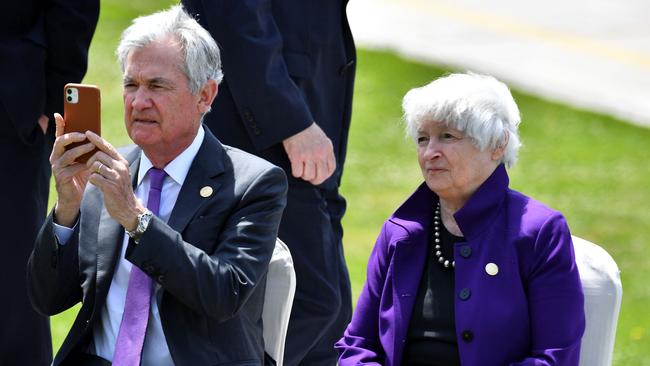
There are only eight months until the end of January 2024 and in that time, according to traders of interest-rate securities and derivatives, the US Federal Reserve will cut rates more than three times.
Yes, you heard that right: the US will CUT rates.
Current expectations are for the US Fed Funds target to fall from its current level of about 5.25 per cent to less than 4.2 per cent at the end of January 2024.
To my way of thinking, it’s odd to see tail risks manifest as a consensus forecast.
Why do I say such cuts are “tail risks” or extreme outcomes? Because many conditions in the economy need to turn around for three cuts to be necessary, and humans are notoriously bad at predicting turning points.
Investors tend to be reasonably good at extrapolating the recent past into the future because very little skill is required. Historically, however, the market’s smooth continuation is frequently interrupted by extreme outbursts of volatility – meaning investors get surprised by something – usually an event that required a substantial recalibration of those smooth forward expectations.
To put it another way, if turning points could be predicted, the market wouldn’t react to their arrival with so much surprise, and less volatility would be the enduring benefit.
Rate cuts, seriously?
For the US Federal Reserve to cut rates at least three times before the end of January, one or more of the following three scenarios must transpire.
GIVEN that rates moved up materially due to inflation, let me first address what inflation needs to do for the US central bank to be amenable to slashing rates by January next year.
Inflation must fall to the Fed’s target of circa 2 per cent – and quickly. Anything is possible, of course, but given the annualised run rate for US inflation is at least 3.6 per cent, some significant economic slowing is required for inflation to fall that much.
And even if inflation did fall to 2 per cent, there is no guarantee the Fed would immediately reverse course and commence cutting rates. For that to happen some other accompanying slowing would be required.
LABOUR costs is the obvious candidate but labour remains still tight in the US; and while lay-off data is ticking up, we’re not talking about a broadbased change of course for unemployment. Indeed, since the Fed started raising its rate range from near zero in March 2022 to over 5 per cent today, unemployment has declined from 4 per cent to around 3.4 per cent. Of course, there are lags to contend with but the decline in unemployment over the past 12 months makes the journey to a higher unemployment rate that would satisfy the Fed, that much longer.

As one commentator pointed out, the US economy added almost five million jobs last year and it’s added more than a million jobs so far in calendar 2023. By the way, that’s alongside the prime-age labour force growing to an all-time high of 106.5 million people.
Curiously, it seems right to question how much control of these things the Fed actually has.
Despite raising rates at its fastest rate in history, unemployment has fallen. A cynic might suggest that when inflation was declining, rate cuts did nothing to stop the decline, and now rate hikes appear to be contributing relatively little to bringing inflation down.
So far, it doesn’t look like inflation will plunge in the requisite time to ameliorate the current elevated rate environment. And it doesn’t look like the “hot” labour market is buckling enough to warrant a change of course by the central bank.
THAT leaves only the possibility of recession itself. Judging from the results just in from the US first-quarter reporting season, corporate profits don’t appear to be signalling a rapid deterioration in the state of the economy.
Expectations for aggregate corporate profit declines of between 8 and 9 per cent failed to materialise.
Analysts expected first-quarter earnings to be “ugly,” but importantly, they also expected the quarter to market the “low point” in the earnings cycle. It wasn’t much of a low point because earnings growth came in a much better-than-expected negative 2.5 per cent.
It was the second consecutive quarter of negative earnings growth, but analysts were way too bearish. Fully 78 per cent of S&P 500 companies reported positive earnings per share surprises, while three-quarters of S&P 500 companies reported a positive revenue surprise.
More importantly, the earnings outlook for the second quarter has been less negative compared with recent averages.
According to FactSet, 57 per cent of S&P 500 companies that have issued EPS guidance for the second quarter have issued negative guidance.
That sounds terrible, but one has to keep in mind this percentage is below the five-year average of 59 per cent and also below the 10-year average of 67 per cent.
It’s a prediction, stupid!
If corporate profits are not turning out to be a portent of recession, then perhaps the failure of several US regional banks will do so.
It is certainly possible that any resultant credit tightening could change the course of jobs, profits and inflation. Still, the transmission mechanisms take time and, as we’ve pointed out, there are only eight months remaining between now and the end of January for all this to happen with such force that the Fed would be motivated to cut three times.
If the interest rate market’s investors have their rate predictions wrong, it seems their prediction of recession might also be wrong.
If no recession transpires, investors might conclude that the economy is growing with disinflation in place.
Of course, as I have regularly pointed out in these pages, it is important to distinguish between the “market” and individual companies. I don’t invest in the market index, so I am more interested in the performance and prospective returns of higher-quality underlying businesses, or in fund managers which invest in those superior companies.
Still, since the 1970s the combination of positive economic growth and disinflation has been incredibly positive for shares, especially innovative growth stocks, many of which are found in small-cap land.
It’s no surprise then, with these conditions in place since the start of the year, the Nasdaq is up nearly 20 per cent. Investors holding off awaiting a recession may regret their decision.
Roger Montgomery is founder and chief investment officer at Montgomery Investment Management




Something weird seems to be going on with the US interest rate market and it has implications for shares – especially small cap shares – for the remainder of the year.